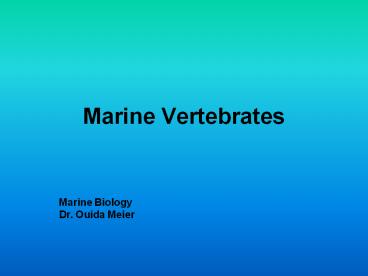Marine Vertebrates - PowerPoint PPT Presentation
1 / 14
Title:
Marine Vertebrates
Description:
Marine Vertebrates Marine Biology Dr. Ouida Meier Representative Marine Phyla: Phylum Porifera Phylum Cnidaria Phylum Bryozoa Phylum Mollusca Phylum Annelida Phylum ... – PowerPoint PPT presentation
Number of Views:969
Avg rating:3.0/5.0
Title: Marine Vertebrates
1
Marine Vertebrates
- Marine Biology
- Dr. Ouida Meier
2
Representative Marine Phyla
- Phylum Porifera
- Phylum Cnidaria
- Phylum Bryozoa
- Phylum Mollusca
- Phylum Annelida
- Phylum Arthropoda
- Phylum Echinodermata
- Phylum Chordata
3
Phylum Chordata
- Subphylum Urochordata
- Class Ascidiacea (tunicates)
- Class Thaliacea (salps, gelatinous thaliaceans)
- Subphylum Vertebrata this week.
All chordates possess at some time during
development a notochord (made of cartilage) along
midline of body, below a hollow dorsal nerve
cord, as well as a postanal tail and pharyngeal
pouches.
4
Subhylum Vertebrata
- Class Agnatha (jawless fish)
- Class Chondrichthyes (cartilaginous fish)
- Class Osteichthyes (bony fish)
- Class Reptilia (reptiles)
- Class Aves (birds)
- Class Mammalia (mammals)
5
Subphylum Vertebrata
- Class Agnatha (jawless fish)
- Class Chondrichthyes (cartilaginous fish)
- Class Osteichthyes (bony fish)
- Class Reptilia (reptiles)
- Class Aves (birds)
- Class Mammalia (mammals)
Whos missing?
6
Features of Vertebrates
- Postanal tail, pharyngeal pouches (chordate)
- Vertebral column (develops from notochord
segmented) - Specialized sensory organs
- Brain at anterior end of nerve cord
- Closed-loop circulatory system (heart, arteries,
capillaries, veins) - Myomeres (muscle segments)
7
Marine Fish
- Agnatha hagfish (most primitive), lampreys
- body fluids isotonic to seawater 30-50 in
other vertebrates - Chondrichthyes sharks, skates, rays
- large lt20cm to gt15m
- Osteichthyes bony fishes tarpon, eels salmon,
sardines, lanternfish, toadfish, flying fish,
seahorses, pipefishes, scorpionfishes, sculpins,
basses, groupers, snappers, barracudas, wrasses,
tunas, triggerfishes, molas, pufferfish, etc. - bone stronger and lighter than cartilage small
size, diverse adaptations and habitats
8
Body shape specialization
- High maneuverability (e.g., butterflyfish)
- Rapid acceleration (e.g., barracuda)
- Efficient cruising (e.g., tuna)
- Eating methods
- Ramming (e.g., sharks)
- Biting (e.g., triggerfish)
- Sucking (e.g., butterflyfish)
9
Marine Reptiles
- Snakes (61 species of true sea snakes, most of
them highly venomous) - Turtles (7 species of sea turtles)
- Iguanas (1 species of marine iguana, Galapagos
Islands) - Estuarine environments additional snakes,
caymens, alligators, crocodiles)
10
Marine Birds
- Feathers and front appendages adapted for flight
- Species range of dependence on marine
environment - Ducks, geese, coots
- Shorebirds herons, stilts, sandpipers
- Albatrosses, petrels, gannets, pelicans, gulls,
terns, murres - Penguins
- Birds and Mammals are true homeotherms
11
Marine Mammals
- Order Carnivora
- Pinnipeds Seals, sea lions, walruses, sea otters
- Polar bears
- Order Cetacea
- Whales, dolphins, porpoises
- Order Sirenia
- Manatees, dugongs
12
Characteristics of mammals
- Viviparous
- Body hair
- Milk-secreting mammary glands
- Specialized teeth
- Separate reproductive / digestive tract openings
- other vertebrate groups oviparous or
ovoviparous, and have a cloaca
13
Modern cetaceans
- Suborder Mysticeti baleen whales lack teeth
have rows of baleen projecting from upper jaw to
filter-feed - Suborder Odontoceti toothed whales smaller
specialized teeth help capture slippery fish,
squid, other prey
14
Links
- Basic background on marine mammals
- Pinniped photo gallery
- Cetacean photo gallery
- National Marine Mammal Lab, Cetacean Assessment
Program - Sea Otter Evolution and Adaptations

